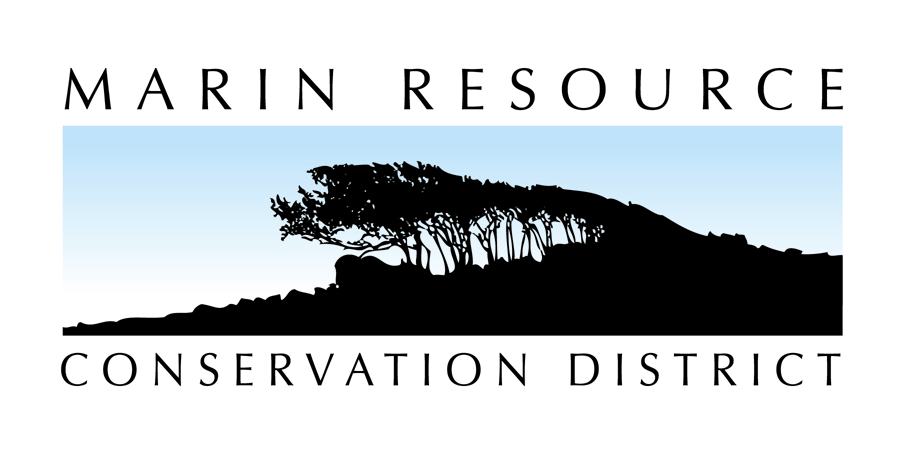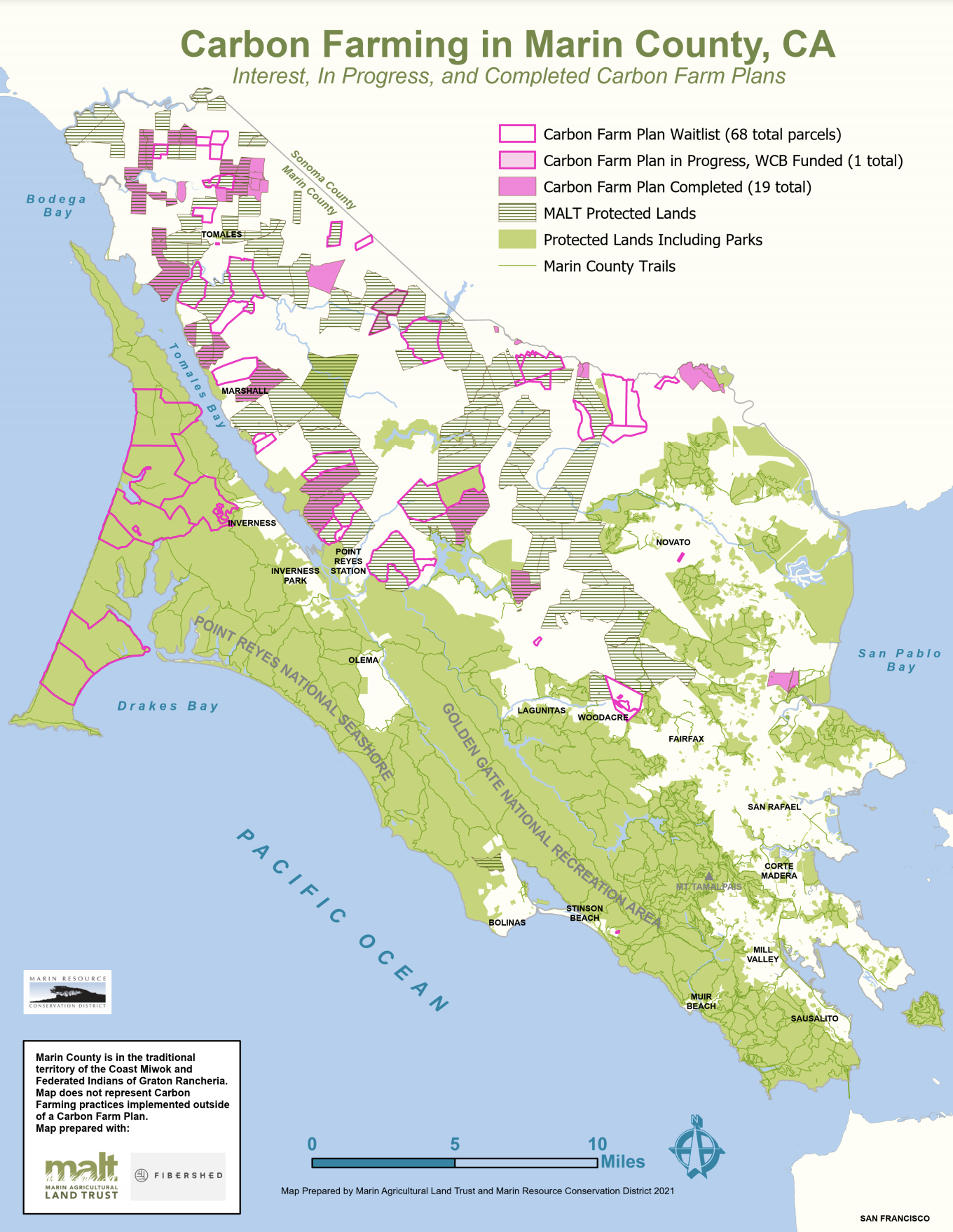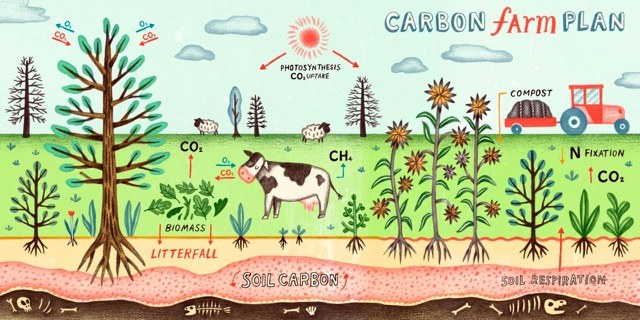CARBON FARMING OVERVIEW
Marin RCD’s Carbon Farming Program
In our Carbon Farming Program, the Marin RCD provides farmers and ranchers with financial and technical assistance for the planning, design, and implementation of carbon beneficial practices.
Since 2008, Marin RCD has been directly involved in carbon sequestration research, planning, and implementation as a partner in the Marin Carbon Project. The Marin Carbon Project – a partnership of local agricultural, conservation, and County organizations – seeks to assist landowners and land managers in serving as stewards of soil health and undertaking carbon farming in a manner that can improve on-farm productivity and viability, enhance ecosystem functions, and stop and reverse climate change.
As of 2020, Marin RCD and partners in the Marin Carbon Project have completed 19 Carbon Farm Plans. Presently, Marin RCD is writing one new plan and has a waitlist of 68 parcels interested in receiving one! Contact us if you would like to be added to our list.
Check out the expanding local interest in Carbon Farming!
Updated April 2021. Click the map to download the PDF.
For more on technical and financial assistance, see the “Funding” sidebar, and our other Carbon Farming web pages linked here:
- Carbon Farming: Planning
- Carbon Farming: Design and Implementation Page
- Carbon Farming: CDFA Healthy Soils Page
On December 2020, the Marin Board of Supervisors adopted an updated Climate Action Plan that outlines how the County will mitigate and adapt to climate change and sets targets and measures for 2030. As noted on page 46 of the plan: “the agricultural sector can reduce emissions from production, sequester carbon and build soil carbon stocks, and play a role in cross-sectoral efforts to enhance the ecological benefits to natural lands.”
All to say, Carbon Farming is and can be part of the solution to meeting our local climate adaptation and mitigation goals! Read more here.
What is Carbon Farming?
¿Qué es el Cultivo de Carbono?
Plants “breathe” in atmospheric carbon and convert it into sugar so they can grow, through the process of photosynthesis. Plants transport some carbon, in sugar form, to their roots to trade fungi for minerals or to store for a later time when the need food. When the carbon gets to the soil, it interacts with the soil ecosystem and a variety of things can happen. Depending on how the plant and soil is managed (or not), the carbon can remain in the soil for long-periods of time in a stable state—that is, become sequestered within the soil. The phrase ‘carbon farming’ means implementing farming practices that capture and hold carbon in vegetation and soils and/or reduce greenhouse gas emissions. Carbon farming includes simple to technologically-advanced practices – like not tilling the soil, planting a cover crop, prescribed grazing, to installing an anaerobic methane digester. Carbon Farming practices can also lead to improvements in soil health, water holding capacity, crop and forage productivity, water conservation, on-farm habitat, biodiversity, and climate resiliency.
Listen to the NPR story: Farming Releases Carbon From The Earth’s Soil Into The Air. Can We Put It Back?
Soil Organic Carbon
The cycling of the element, carbon, is fundamental to life on earth. One main phase of the carbon cycle is when carbon is stored in soil. ‘Soil organic carbon’ (SOC) – the amount of carbon stored in the soil – is a component of soil organic matter and is the basis of soil fertility. SOC releases nutrients for plant growth, promotes the structure, biological and physical health of soil, and is a buffer against harmful substances. A 1% increase in soil organic matter – a majority of which is carbon – will hold 20,000 gallons more water per acre!
Frequently Asked Questions (FAQ’s):
Are Marin RCD and Marin Carbon Project the same thing?
- No. Marin RCD is only one of the many partners that make up the collective known as the Marin Carbon Project. Other partners in the collective include: Carbon Cycle Institute, Marin Agricultural Land Trust, Marin County, Marin County Agricultural Commissioner, Marin Organic (past member), Marin UC Cooperative Extension, University of California at Berkeley, Silver Labs, USDA Natural Resources Conservation Service (NRCS), and John Wick of Nicasio Native Grass Ranch. Marin Carbon Project does not have any staff. Visit the Marin Carbon Project website to learn more.
How can I get on your waitlist if I am interested in receiving a Carbon Farm Plan?
- Please fill out our contact form, send an email to sarahs@marinrcd.org, or call us at 415-663-1170. Note: to be eligible to work with Marin RCD to receive a Carbon Farm Plan, your land must be in Marin County and must be in agricultural production.
How are farms selected to receive a Carbon Farm Plan from Marin RCD?
- When Marin RCD is awarded funding to write carbon farm plans, either past ranking lists are consulted, or Marin RCD will run a new solicitation round. If running a new round, all agriculturally zoned parcels in Marin County will be sent a solicitation notice asking if they want to apply to receive a Carbon Farm Plan. Those on the Carbon Farm Plan waitlist will also be notified by email or other means.
- Interested farms will be visited by a Technical Advisory Committee who will rank the farm against a selection criteria. Among other things, the selection criteria scores for the potential GHG sequestration potential of the farm, co-benefits including wildlife habitat and hydrologic improvements, and the landowner’s commitment to the planning and implementation process.
- The highest ranking farms will be selected to receive a Carbon Farm Plan.
What are some resources to learn more about Carbon Farming?
From one of our Carbon Farmers in Marin:
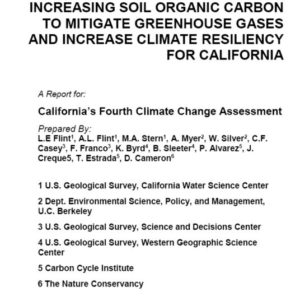
This study considers the multiple benefits of increasing soil organic matter across California’s working lands and supports the USDA Natural Resource Conservation Service estimate that a 1% increase in soil organic matter on 1 acre results in a 1 acre-inch increase in soil water holding capacity. The study finds that: “increases in total soil organic matter of 3% increased the soil water holding capacity by up to 4.7 million acre-feet” across about 44 million working land acres in California.
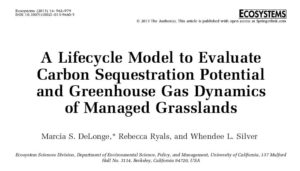 This study was developed to evaluate opportunties for climate change mititgation through soil amendment applications. The study finds that: “producing compost and applying it to rangelands has the potential to significantly offset GHG emissions” and, more specifically, that “compost amendments could result in significant offsets to greenhouse gas emissions, amounting to over 28 MMg [million metric tons] CO2e when scaled to 5% of California rangelands”. For more specifics, see the Upscaling section: “We scaled up results to determine potential reional impacts of soil amendment-based management strategies (Table 4; Figure 7). Over a county-level region (65,000 ha), compost applications as described in the initial case study led to a reduction in the net greenhouse gas flux of 1.5 MMg CO2e over 3 years. This is nearly equivalent to an offset of 10% of the annual emissions from the California commercial sector, which is the economic sector that includes categories such as food services, health care, education, and retail (CARB 2011). Extended to 5% of California rangelands (1,275,000 ha), this strategy would offset nearly 1 year of emissions from the California agriculture and forestry sectors (over 28 MMg CO2e, CARB 2011); although this estimate is based on 3 years of enhanced NPP, the majority of the benefit was obtained in the first year.”
This study was developed to evaluate opportunties for climate change mititgation through soil amendment applications. The study finds that: “producing compost and applying it to rangelands has the potential to significantly offset GHG emissions” and, more specifically, that “compost amendments could result in significant offsets to greenhouse gas emissions, amounting to over 28 MMg [million metric tons] CO2e when scaled to 5% of California rangelands”. For more specifics, see the Upscaling section: “We scaled up results to determine potential reional impacts of soil amendment-based management strategies (Table 4; Figure 7). Over a county-level region (65,000 ha), compost applications as described in the initial case study led to a reduction in the net greenhouse gas flux of 1.5 MMg CO2e over 3 years. This is nearly equivalent to an offset of 10% of the annual emissions from the California commercial sector, which is the economic sector that includes categories such as food services, health care, education, and retail (CARB 2011). Extended to 5% of California rangelands (1,275,000 ha), this strategy would offset nearly 1 year of emissions from the California agriculture and forestry sectors (over 28 MMg CO2e, CARB 2011); although this estimate is based on 3 years of enhanced NPP, the majority of the benefit was obtained in the first year.”
